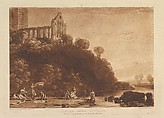Dumblain Abbey, Scotland, part XI, plate 56 from "Liber Studiorum"
Designed and etched by Joseph Mallord William Turner British
Engraver Thomas Goff Lupton British
Publisher Joseph Mallord William Turner British
Not on view
Turner distilled his ideas about landscape In "Liber Studiorum" (Latin for Book of Studies), a series of seventy prints plus a frontispiece published between 1807 and 1819. To establish the compositions, he made brown watercolor drawings, then etched outlines onto copper plates. Professional engravers usually developed the tone under Turner's direction, and Lupton here added mezzotint to detail Dunblane Abbey, whose ruins overlook a river from a wooded bank. Below, women wash clothes and the waterway winds away at right towards a distant bridge. The composition relates to a drawing made during the artist's 1801 Scottish tour, and the letter "A" in the upper margin indicates his category of Architectural landscape.
Due to rights restrictions, this image cannot be enlarged, viewed at full screen, or downloaded.


